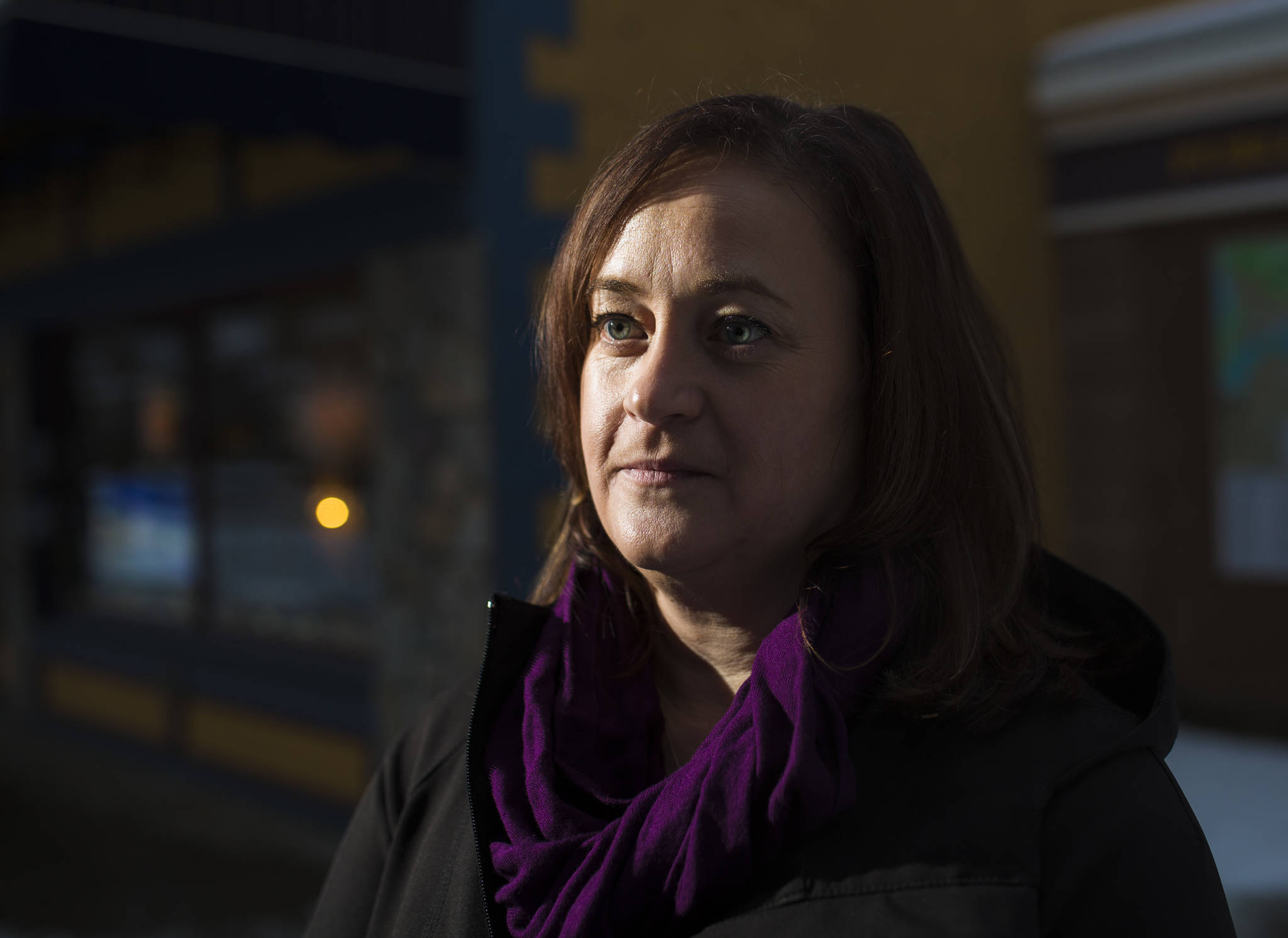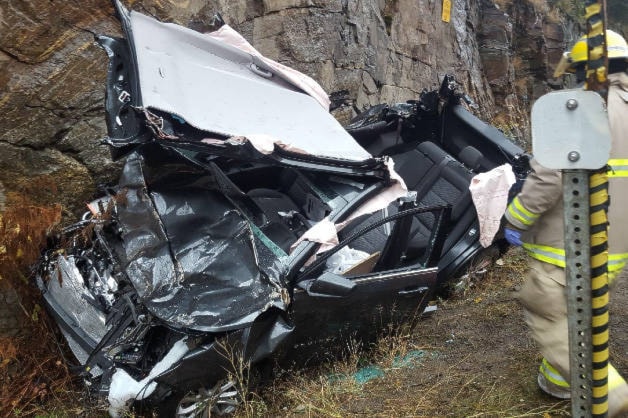The storm swept through the Interior. It tore down branches and twisted leaves; took down whole trees.
On the rail line east of Revelstoke, a tree suspended a train’s progress. And on a rocky bluff in Three Valley Gap, the cliff started leaking rocks onto the highway below.
In Salmon Arm, crews worked to clear debris off the roads.
Shannon and Ian Smith were delayed on their journey home. They were driving together as a convoy – Ian in front and Shannon pulling up the rear in their newly-bought 2018 Chevrolet Equinox – the empty-nesters’ first new personal vehicle in almost a decade.
The Smiths own two businesses in town Classic Collision and Selkirk Car Rental. Their mechanic shop business partner owns the towing company.
The couple finds themselves on the Trans-Canada Highway between Revelstoke and Salmon Arm at least once a week.
For Shannon, it’s never the leaving town that’s difficult; it’s coming home.
“It’s stuff you can’t see. You can’t predict something is going to come down,” says Shannon. “I almost feel it’s the rock bluff, knowing it can fall at any time.”
And on Oct. 17, the wall came down.
Shannon is born and raised Revelstoke blood. Her grandfather helped build the notorious section of highway between Revelstoke and Craigellachie. The two-lane thoroughfare that connects Canada’s east and west coasts snakes between sheer rock face and cold water, where, when the time is ripe, rocks fall from the sky.
“He’s always said that … they should’ve always done a snowshed there,” says Shannon. “It’s always been sluffing. It’s always been an issue. It’s always been there.”
Shannon and Ian take their time driving home. They are stopped a handful of times as crews continue to clear downed trees. At one stop, three unmarked suburbans whisk by – on their way to a high-risk checkstop in Revelstoke.
The rain has stopped as they approach Three Valley Gap. A tow truck sits with a car whose windshield looks like a spider’s web.
As Shannon comes alongside the bluff, she sees a rock the size of a football come down.
Great, she thinks. Typical Three Valley Gap.
Her world goes black.
Shannon doesn’t know what she hits first, but after that first impact, she cranks the wheel right. “So I hit the wall instead of going into the water,” she says. “I didn’t want to go in the water.”
At her second impact, she thinks she’s hit her husband. Ian is fine, driving ahead and watching the whole scene unfold in his rear-view mirror: the bluff is coming down on his wife – trees and sediment and boulders alike – and it’s coming from the top.
At Shannon’s third impact, she comes to a stop in the ditch as the foot of the bluff.
Three Valley Gap is a notorious stretch of highway. Even as government work projects to twin sections of Hwy. 1 near Golden, near Salmon Arm, near Kamloops, the highway around Revelstoke gets neglected.
“Our area is notoriously dangerous,” says Shannon. “We’re called Revelstuck for a reason, whether it’s summer or winter.”
Summer mudslides close highways just as well as winter avalanches, or autumn rock sluffs.
The Ministry of Transportation and Highways says that other solutions have been sought and looked at for Three Valley Gap. The highway base isn’t strong enough for a snowshed. It’s not possible to reroute to the other side of the valley. The same rockfall and avalanche hazard would also exist there.
The Ministry of Transportation and Infrastructure says that its top priority is the safety of the travelling public and that every effort is made to protect them.
“Safety in Three Valley Gap Revelstoke is a priority for our ministry and we have expanded avalanche reduction program in the area with a total of nine new Remote Avalanche Control Stations in place for this avalanche season,” it said in a statement to the Revelstoke Review. “Weather conditions (extended periods of hot and dry weather, heavy rainfall, and significant localized wind storms) contributed to rock fall activity in the Three Valley Gap area this past summer.”
The Ministry says that while the area has been identified as needing more stabilization work on its slopes, typical rock fences may not be appropriate.
“Typical rock fall fences cannot survive snow loads and significant snow avalanche activity that occurs at this unique area during the winter months,” it says.
New designs are being looked at that could be a good fit in Three Valley Gap.
“The intent would be to install and test a new rock fall fence system at a select area of Three Valley Gap,” the Ministry says. “If successful, the system could then be expanded to other rock fall areas in the Three Valley Gap area site.”
Shannon remembers the airbags and the little puff of smoke as the steering wheel bag deflates. Ian calls to her and his head appears beside her at the driver’s window.
Shannon looks the same as she does today, plus three little scratches – “Less than what a cat would scratch,” she says.
Ian stays with her as they wait for the emergency crews. A loader, stationed there for the day has radioed for help. The area is a dead zone. No OnStar. No cell service.
“I kept turning to look at him and he was yelling stop turning you head,” she says.
Shannon stays with one hand on the door handle and braces the other on the console until Mel crawls into her car and keeps her calm as firefighters cut the top off the hours-old car.
When the top is peeled back, the inside of the car still looks brand new.
“They literally just lifted me out of the car and put me on the stretcher,” says Shannon.
As she lays on it, she looks down the highway at a long line of vehicles.
“Everyone has a you’re the reason the highway was closed story,” says Shannon.
She escaped from the crash with those three little scratches and a fractured 12th vertebrae.
Shannon wrote her first letter in late November. She couldn’t sit or stand long enough to write before that and couldn’t put any weight in her lap, but she was able to set up a standing office at her kitchen island. She’d type a bit and then sit down. That was the rhythm of her life for weeks. Shower. Sit. Hair. Sit. Rest. Makeup. Sit.
Things are getting better. She’s starting to walk farther distances and has picked up a few household chores. She may start back at work in the new year.
“It’s amazing how it changes your whole perspective of things,” she says of her injury.
Politicians are listening to Shannon. Her letter has been shared with all levels of government and her story is in the media. She’s hoping her experience can help affect some change.
“I just want to make it safer,” she says. “If I can get something done, that’s all I want.”
Shannon accepts that change at any level of government can be slow, but she is offering what she calls a “Band-Aid solution”: mesh.
“Mesh would stop the little bits and pieces coming down,” she says. But, “it wouldn’t have stopped what happened to me.”
There’s not much to be done when a cliff falls onto itself.
But Shannon’s hope is that the next time it happens, no one will be hurt: not a school bus full of kids on a field trip or a sports car or a semi-truck. “I just want to know after my accident I’ve done something to prevent it from happening to someone else.”
@marissatiel
marissa.tiel@revelstokereview.com
Like us on Facebook and follow us on Twitter.

